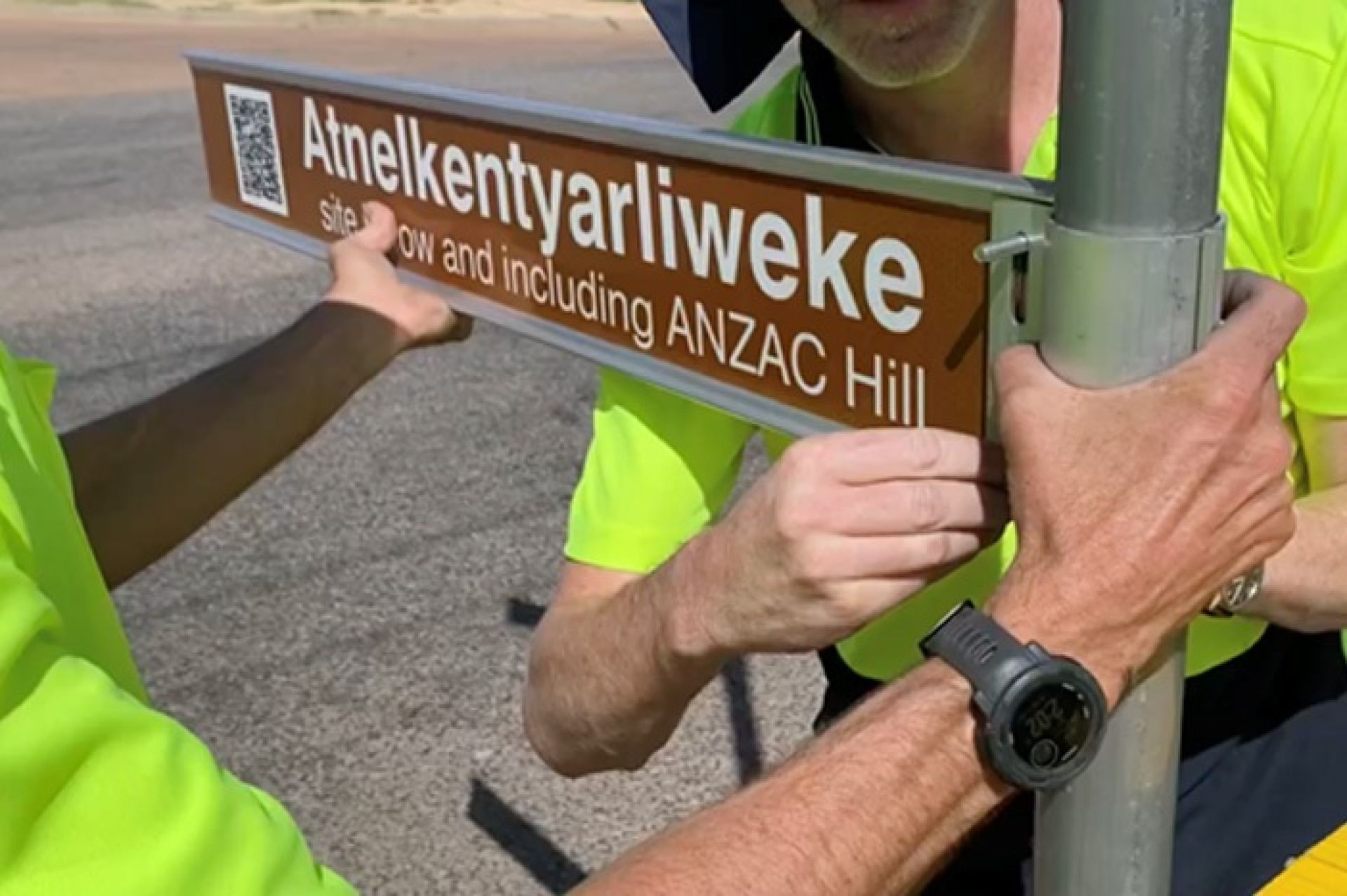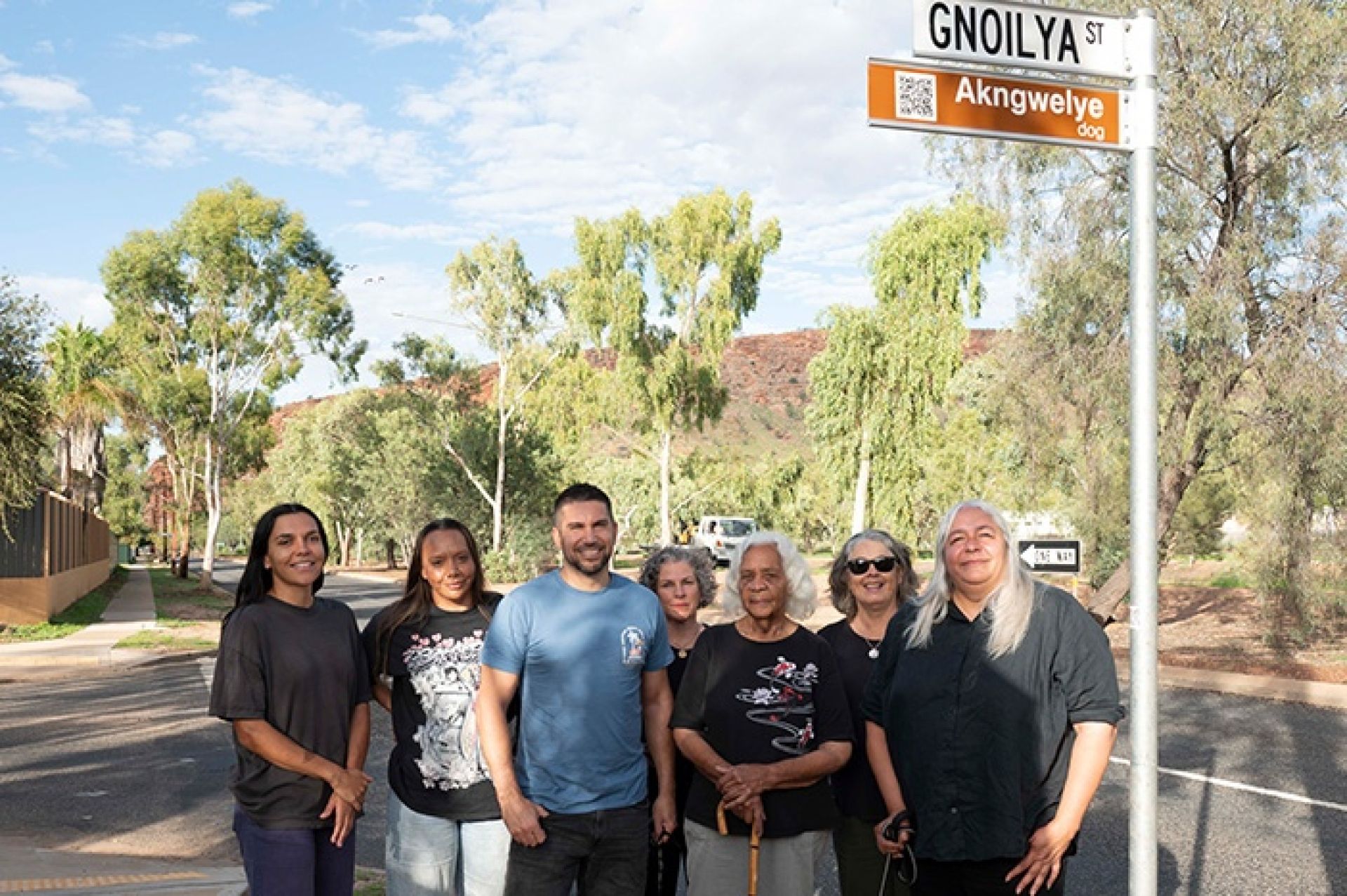
From Wednesday 16 April 2025, Mparntwe (Alice Springs) residents may have noticed the appearance of 35 additional street signs around town, enabling residents to listen to and learn the correct pronunciations of their street names via a QR code.

Arrernte people have always had names for the hills, rivers and other features of the landscape within Arrernte Country. The names tell the ayeye altyerre (creation stories) and link apmere (Country) to Arrernte language, people, and culture.
Mparntwe has a number of street names drawn from Arrernte names for plants, animals and places. The writing of these signs was guided by Arrernte people at a time before there was an agreed and consistent spelling system. It was very hard for non-Arrernte speakers to hear all the sounds of the Arrernte language.
During the 1980s, a standardised Arrernte spelling system, or orthography, was developed in consultation with Arrernte elders alongside linguists. This led to the publication of the popular and widely sought after Central and Eastern Arrernte to English Dictionary (IAD) by Veronica Dobson and John Henderson in 1994. The dictionary, as well as the online resource
arrernte-angkentye.online (Batchelor Institutes CALL & UWA) features wordlists with audio, also available for people who want to learn more about Arrernte word meanings, spelling and pronunciation. Veronica Dobson Perrurle, author of the Central and Eastern Arrernte to English Dictionary, says the project brings this knowledge to our streets.
“This is a good project to work on, making sure the language is written down properly and getting the proper names on the streets of Mparntwe (Alice Springs). The language is changing. Some of the signs are examples of the older language that needs to be kept strong.”
This project Angkentye-yerrtye ileme mpwarele loosely translates to 'Bringing back the right names'. It respectfully presents the correct spellings of our street signs using the Central and Eastern Arrernte standard spelling system. In addition to that, it provides an Arrernte description of the name as well as a brief English summary.
“We are so proud that our beautiful language is being preserved in street signs,” Camille Dobson says. “It is important to the future of the Arrernte language that people have the opportunity to see and hear Arrernte around them in the town of Mparntwe, and to use consistent spelling to keep the language going strong,”
Developed over two years, the project was supported by Batchelor Institute Language Centre, CALL, and by Indigemoji, the occasional collective who developed Australia’s first set of First Nations emojis in 2018, making them available through a free app. Indigemoji language consultant Joel Liddle says Angkentye-yerrtye ileme mpwarele has been years in the making.
“This project was simmering away in the background for a few years actually,” he says. “I’d see the Arrernte names on street signs, but they were written using phonetic script, basically ‘write it as you hear it’ approach. It meant the words weren’t being pronounced correctly.
When you use phonetics, 100 people could spell a word 100 different ways and you end up with mispronounced words that don’t have a meaning in either English, or Arrernte.”
“Our language has been written for nearly five decades, and our Elders and language speakers have been publishing materials and learning resources for many years. We wanted to bring the names on the signs to life. Some may not have even realised that their street had an Arrernte name. So, we did this just as an easy way to teach people, and with the QR codes, everyone can hear how to say it properly, know what it means and see that we do write in our language. Languages of Central Australia are really important, and writing them using the orthographies that have already been in use for a long time is a great way to safeguard them for future generations, whilst also promoting the importance of Arrernte language literacy throughout the region”.
This project has been discussed with stakeholders over many years, and everyone has expressed support. Stakeholders value the opportunity created for local residents and visitors to learn about the local Aboriginal language. The street signs are designed to be visually different from current signage and are not intended to replace existing street signs - rather, they offer an opportunity for people to engage with Arrernte culture in a respectful way.
Residents are encouraged to share photos of the signs on social media.

More information: www.angkentye-yerrtye-ilemele-mpwarele.com Contact: werte@indigemoji.com.au
Credits
Article: Streetsigns group
Photos: Sara Maiorino
